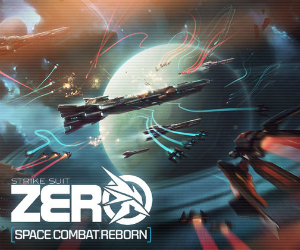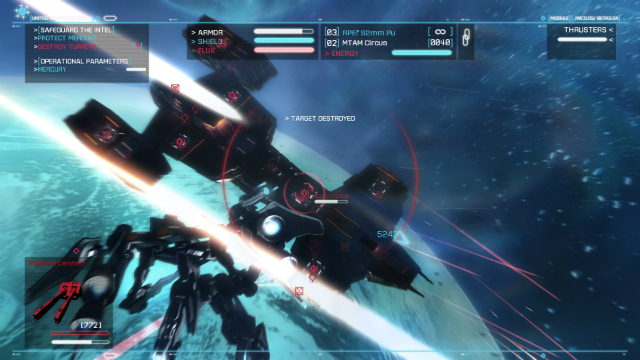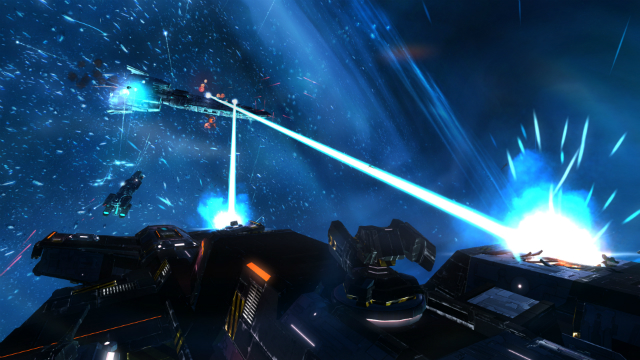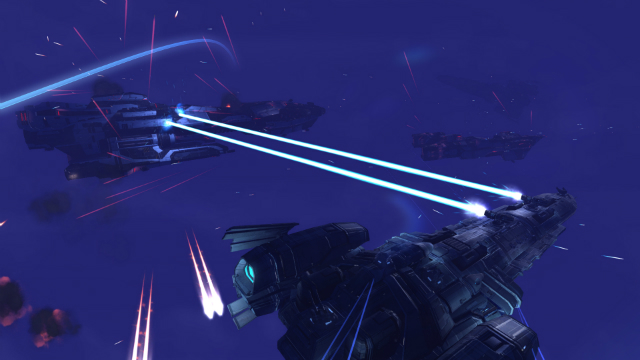 Game: Strike Suit Zero
Game: Strike Suit Zero
Developer: Born Ready Games
Publisher: Born Ready Games
Available on: Windows PC Only
Kickstarter is becoming a strange and powerful beast. On one hand it’s helping to create games that didn’t get made the conventional way because they shouldn’t get made, games that may sound good on paper, but when you get your hands on the keyboard (or around a controller, for you savages) don’t quite play as we’d hoped. On the other, more optimistic, hand, Kickstarter can unleash games upon us that are pure brilliance, and only struggled to get picked up because publishers don’t want to take a risk on an unproven studio with a brand new IP. Strike Suit Zero falls squarely into the latter category. It’s a beautiful-looking space flight combat game with a twist, the twist being that you can transform your fighter into a massive space mecha and blast the enemy vessels out of the sky.
So then, does all that awesome-sounding hyperbole mean that Kickstarter and Born Ready Games have actually delivered a game that was well worth all those pledges? Short answer: Yes.

STORY: Strike Suit Zero is a story-driven game. From the very beginning and right to the end you’re pushed through the game by its story, one that encompasses betrayal, hatred, jealousy and even a little bit of racism. It’s not a particularly original story, it’s one that we’ve heard a thousand times before in books, TV shows and films, but it’s told very well with Strike Suit Zero. One thing that it does surprisingly well is make the player understand why they’re flying a huge mecha through the vast emptiness of space. That plot point could have been something that felt silly and tacked on but that never happens, the player will simply believe that Control – an artificial intelligence that has grafted itself onto the mind of a human female doctor – has built it while she was sitting in space doing nothing between the last great battle in the sector and the moment you come across her for the first time. Even the moment when Control asks you to pilot the prototype ship instead of your superior, which could have been a strange plot hole which caused no end of questions, is simply skipped over without so much as a passing mention. There’s clearly something between Control and Adams (your character) but the information just isn’t being revealed – at least, not yet.
It’s this notion that you might find out some more information soon that keeps pushing you through the game and all the way to the end. The game isn’t easy, but the story is good enough to make you want to overcome the difficulties just to see what happens next.
GRAPHICS: Strike Suite Zero is a visually impressive game. The models used for the ships aren’t particularly detailed, but they do their job admirably. It’s the backgrounds to the various missions that will leave you astounded more than the ships themselves. There’s a painted quality to them, making it so that they almost don’t seem like they’re real, as if it’s some kind of crazy dream that the main character is having; but they’re also of high enough quality that players will be sucked into the story and they’ll genuinely care what’s been happening. Take, for example, one such mission, where you “fold in” – the game’s term for faster than light travel – only to find that your entire fleet has been decimated and the planet closest to you has been utterly destroyed by the Colonials. The visual of the broken planet is truly breathtaking and makes you need to find out what happened in this lonely, black corner of space.
The Strike Suit is designed by Junji Okubo, the designer behind the fan-favourite Infinite Space, so there’a a definite anime feel to it when you transform into ‘Strike Mode’. It’s the design of this ship, the Strike Suit, which gives the entire game an edge over its contemporaries in the genre and really sets it apart from the crowd. It’s something for which the game, and Okubo himself, should be applauded.
SOUND: All of the cutscenes within Strike Suit Zero are fully voice acted, so you’re really going to be getting an auditory treat considering that the game only cost $175,000 to make. There are some games out there that cost ten times more than that and we’re still expected to read the mission text! It’s not the best voice-acting in the world but it gets the job done to a relatively high standard, although I did find it odd when Bowman – a character who sounds eerily similar to Saul Tigh from Battlestar Galactica – kept telling me to “destroy the Colonial fleet”. I’ve spent five years of my TV-watching life watching Battlestar Galactica and trying to save the Colonial fleet, so being asked to destroy it in that particular voice just feels odd. I know this is Strike Suit Zero and not Battlestar Galactica: The Game, but I thought it was such an interesting vocal choice that I ought to bring it up.
The music you’ll experience while playing through Strike Suit Zero is composed by Paul Ruskay, composer of all but two songs on one of the first 3D space real-time strategy games, Homeworld. There’s no doubt that Ruskay has made his mark on Strike Suit Zero; his signature Middle-Eastern themes are audible throughout the game, adding a strange historical essence that contrasts with the deep space battles.

GAMEPLAY: The game starts just like any other space shooter would: You’re placed in control of a ship, given a couple of weapons and a target that you’re supposed to destroy, and then sent out into space to do your thing and complete the mission. That’s not to say that Strike Suit Zero isn’t entertaining in these first few levels (in fact, considering that it wouldn’t even have been made if not for Kickstarter, it’s a very impressive game indeed), it’s just that it doesn’t break the mould as much as players may have been hoping.
All that changes during the third mission, however.
From this point onwards you’re in charge of the titular Strike Suit, a prototype fighter that has the ability to switch between two modes. ‘Pursuit Mode’ is the one that most resembles a typical fighter as seen in most sections of the game, which the rest of your squadron will also be flying. In this mode you use all of the weapon systems that you’ve been using during the first and second missions, but by doing so you will generate Flux. Flux is the component required to transform the Strike Suit into its second and most devastating form, ‘Strike Mode’. During ‘Strike Mode’ the Strike Suit will resemble an anime-esque mecha and fire different, more effective weaponry that will take down even the largest enemy vessels without much problem. However, being in this mode will drain your supply of Flux, meaning it can only be sustained for short periods of time and needs to be used sparingly, lending a tactical edge to the game. Do you go into ‘Strike Mode’ now and take out those three Interceptors, or do you save it for that Capitol Ship that you know is waiting just beyond the next checkpoint? It’s up to you to decide, and the choice could change the outcome of the entire battle, so choose carefully.

At the end of each mission you will be scored on your performance; how accurate you were, how many enemy ships you destroyed, how quickly you completed the mission, along with a whole host of statistics – sometimes presenting as many as twelve pages of details. All of these points get added to a point bar which is reminiscent of an experience bar – fill it up and you’ll be awarded a medal, gaining higher value medals the more times you fill up the score bar. There’s every chance that you could work your heart out to complete a mission and not even attain a medal for it. If that happens, playing through the whole level again – some of which last almost half an hour – is the only way to rectify the mistake. If you’re a completionist, or just want all the gold medals, then you better be prepared to replay some pretty lengthy missions.
LONGEVITY: With full achievement support in Steam (and presumably the upcoming Xbox 360 and PlayStation 3 versions) there’s good reason to continue playing Strike Suit Zero, but the longevity of the title stretches much further than mere achievement-hunting. The medals attained at the end of each level are another incentive to replay the missions over and over again, trying to beat their score just that little bit more in order to push it over the edge to a gold medal. It’s not easy to do but that just makes it even more of a challenge and encourage you to try harder.
VERDICT: Strike Suit Zero is an extremely difficult, yet extremely satisfying, space flight combat game. It’s games like this that make me, purely as a gamer, happy that companies such as Born Ready Games can use Kickstarter as a way to generate income for their project. As well as showing the developers that there are people out there who want your title, it allows games that would have struggled to see the light of day to stand on their own two feet. Everything about Strike Suit Zero is a labour of love, from the music and the art style all the way down to the story. It may not all work together as well as the original developers had hoped but the passion is there, and what we’re left with is a very enjoyable and well-made game that, in another time, we simply wouldn’t have been able to enjoy.







